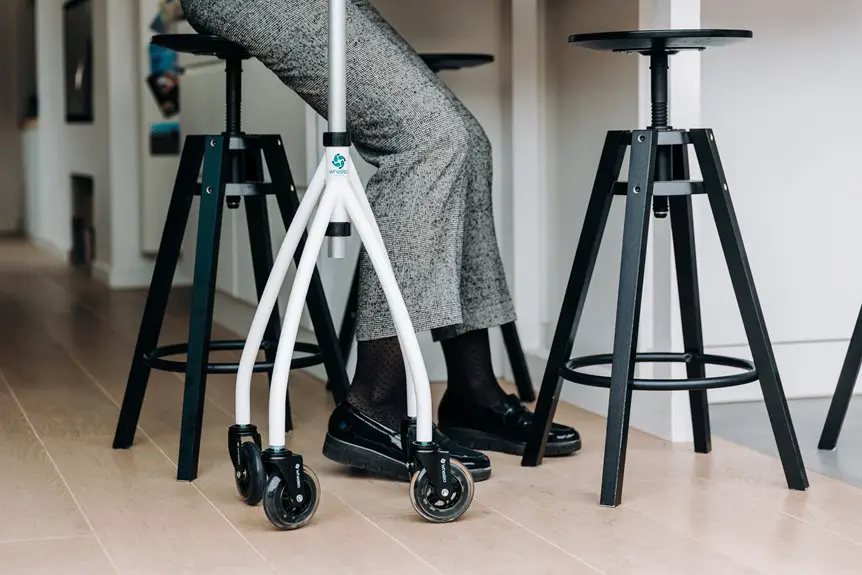Standing on a hard floor all day can definitely harm your leg health. You might experience discomfort, muscle fatigue, and even joint pain due to the lack of cushioning and support. Over time, this can lead to circulation issues and chronic pain. To combat these effects, it’s crucial to wear supportive footwear, take regular breaks, and stretch throughout the day. If you want to discover more about protecting your legs and preventing discomfort, continue on for helpful solutions.
Table of Contents
Key Takeaways
- Prolonged standing on hard floors can lead to muscle fatigue, strain, and discomfort in the legs and feet.
- Continuous pressure on feet contributes to joint pain in knees and ankles due to insufficient shock absorption.
- Standing for extended periods may result in poor circulation, swelling, and a feeling of heaviness in the legs.
- Lack of proper footwear and support can exacerbate discomfort and increase the risk of chronic pain over time.
- It’s essential to take breaks, stretch, and use anti-fatigue mats to mitigate the negative effects of standing all day.
The Physical Effects of Prolonged Standing
When you stand for long periods on a hard floor, your legs can start to feel the strain. The continuous pressure on your feet can lead to discomfort, aching muscles, and fatigue.
Your body has to work harder to maintain balance, which can cause your leg muscles to tire quickly. Poor circulation can also result from prolonged standing, leading to swelling and heaviness in your legs.
Prolonged standing can lead to fatigue and poor circulation, causing tired legs and uncomfortable swelling.
As you shift your weight, those repetitive motions may create tension in your knees and hips. You might notice that your joints feel stiff or sore after a long day.
To combat these effects, consider wearing supportive footwear, taking breaks to sit down, or using anti-fatigue mats to cushion your feet and promote better leg health.
Common Leg Issues Associated With Hard Floors
Standing on hard floors for extended periods can lead to several leg issues you mightn’t even realize are developing.
You could experience muscle fatigue and strain, joint pain, and even circulation problems over time.
Recognizing these common issues is the first step toward finding relief and improving your leg health.
Muscle Fatigue and Strain
Though hard floors may seem harmless, prolonged exposure can lead to significant muscle fatigue and strain in your legs.
When you stand for long periods, your muscles work continuously to support your weight, which can quickly wear them down. You might notice aching or heaviness in your legs as they struggle to cope. This fatigue can make everyday activities feel more challenging and even lead to decreased performance in your work or sports.
Additionally, repetitive strain on your calves, hamstrings, and quadriceps can result in tightness and discomfort.
To combat this, consider using anti-fatigue mats, taking breaks to sit or stretch, and wearing supportive footwear. Your legs will thank you for it!
Joint Pain Development
While you mightn’t notice it immediately, standing on hard floors for extended periods can lead to joint pain in your legs. Your knees and ankles are particularly vulnerable as they absorb shock from hard surfaces.
Over time, the constant pressure can cause inflammation and discomfort in these joints. You may start feeling stiffness or a dull ache, especially after long shifts. Ignoring these symptoms can lead to chronic pain, making it harder to perform daily activities.
It’s important to listen to your body and take breaks when needed. Consider using supportive footwear or anti-fatigue mats to cushion your joints.
Circulation Issues Over Time
Prolonged exposure to hard floors doesn’t just lead to joint pain; it can also disrupt circulation in your legs. Standing for long periods can cause blood to pool, leading to swelling and discomfort. You might notice your legs feeling heavy or fatigued, which indicates poor circulation.
| Circulation Issue | Description |
|---|---|
| Blood Pooling | Blood collects in the lower legs, causing swelling. |
| Varicose Veins | Enlarged veins that can become painful. |
| Numbness and Tingling | Reduced blood flow can result in tingling sensations. |
To counteract these issues, take regular breaks to walk around and stretch, improving blood flow and reducing discomfort.
Understanding the Science Behind Leg Discomfort
When you stand on hard surfaces for extended periods, the impact can strain your legs more than you might realize.
This constant pressure leads to muscle fatigue, making it essential to understand how your body reacts.
Impact of Hard Surfaces
Standing on hard surfaces can greatly impact your leg health, as the rigidity of these floors provides little to no cushioning for your feet and joints. This lack of support can lead to discomfort and strain over time.
| Effect | Description | Recommendation |
|---|---|---|
| Joint Pain | Increased stress on knees and ankles | Use cushioned mats |
| Foot Discomfort | Lack of arch support can cause pain | Wear supportive footwear |
| Circulation Issues | Reduced blood flow from prolonged standing | Take regular breaks |
| Muscle Tightness | Tension builds in calves and thighs | Stretch periodically |
| Fatigue | Prolonged standing leads to overall tiredness | Alternate between sitting/standing |
Understanding these impacts can help you take steps to mitigate potential leg health issues.
Muscle Fatigue Mechanism
As you spend extended periods on hard surfaces, your muscles can quickly become fatigued due to the constant demand for support and stability. This fatigue arises as your muscles work tirelessly to maintain balance and posture, leading to discomfort and strain.
You might experience:
- A heavy sensation in your calves, like they’re weighed down by bricks.
- A burning feeling, similar to working out without a break.
- Throbbing aches that pulse with each heartbeat.
- Tightness in your thighs, as if they’re being wrapped in a vice.
Understanding this fatigue mechanism helps you recognize the importance of taking breaks and incorporating rest periods into your day.
Preventative Measures for Those Who Stand All Day
Although many jobs require you to be on your feet all day, there are effective measures you can take to protect your leg health.
First, invest in supportive footwear that provides cushioning and arch support. Consider using anti-fatigue mats to reduce the impact on your legs.
Take regular breaks to sit down and elevate your legs, which helps improve circulation. Stretch your calves, hamstrings, and quads throughout the day to alleviate tension.
Staying hydrated is essential, as it helps maintain muscle function.
Finally, practice good posture by keeping your weight evenly distributed on both legs and avoiding locking your knees.
Implementing these simple strategies can markedly reduce discomfort and promote better leg health while you work.
Ergonomic Solutions for a Healthier Work Environment
Creating an ergonomic workspace is essential for minimizing the risks associated with prolonged standing. By incorporating the right tools and adjustments, you can greatly enhance your comfort and overall leg health.
Consider these solutions:
- Anti-fatigue mats: These cushioned surfaces provide support, reducing pressure on your legs.
- Footrests: They allow you to shift your weight and improve circulation, offering a break for your feet.
- Adjustable workstations: Switch between sitting and standing to keep your body moving and engaged.
- Proper footwear: Invest in shoes with arch support and cushioning to absorb shock and promote alignment.
Implementing these ergonomic solutions can help you maintain your well-being while standing for extended periods.
When to Seek Professional Help for Leg Pain
Even with ergonomic solutions in place, you might still experience leg pain from prolonged standing.
If your discomfort persists for more than a few days, it’s time to reflect on seeking professional help. Pay attention to any swelling, numbness, or sharp pain, as these could signal a more serious condition.
If you notice pain that worsens with activity or affects your daily life, don’t hesitate to consult a healthcare provider. They can assess your symptoms, recommend treatment options, and suggest tailored exercises to alleviate your pain.
Ignoring persistent leg pain can lead to further complications, so it’s better to be proactive. Remember, your leg health is essential for your overall well-being, so prioritize it by seeking help when needed.
Frequently Asked Questions
Can Standing on Hard Floors Affect My Overall Posture?
Yes, standing on hard floors can negatively impact your overall posture. It may lead to muscle fatigue and strain, causing you to slouch or adopt an improper stance, which affects your spine’s alignment and comfort.
What Types of Shoes Are Best for Standing All Day?
When you’re standing all day, choose shoes with good arch support, cushioning, and a wide toe box. Look for breathable materials and non-slip soles to enhance comfort and stability throughout your long hours on your feet.
Are There Specific Exercises to Relieve Leg Pain From Standing?
If standing feels like a marathon, you’ll want to try calf raises, hamstring stretches, and ankle circles. These exercises boost circulation, relieve tension, and keep your legs feeling lighter than air after a long day!
How Does Age Impact Leg Health When Standing for Long Periods?
As you age, your muscles and joints may weaken, making it harder to stand for long periods. You might experience more fatigue and discomfort, so it’s vital to take breaks and stretch regularly.
Is It Necessary to Take Breaks While Standing on Hard Floors?
Imagine a dancer on stage, gracefully moving yet feeling the strain. When you’re standing on hard floors, taking breaks isn’t just beneficial; it’s essential. It helps reduce fatigue and keeps your legs feeling fresh and strong.



